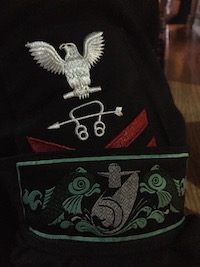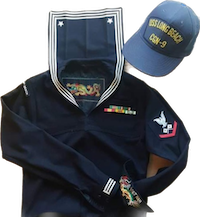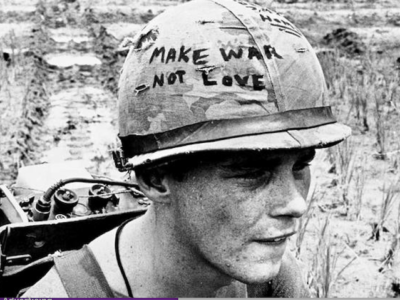Ask anybody who has ever been in the military, and they will tell you wearing a uniform is serious business. Everything must be exact to regulations and that uniformity must be across the board. There is no individuality when it comes to wearing the uniform of one’s branch of service. Woe be it to the Marine who does not have his ribbons in their correct order of precedence or whose trousers are not worn in the prescribed manner, at the prescribed length. However, the American serviceman is an individual and sometimes that individuality manages to surface even when wearing the uniform.
 This is especially true in certain circumstances where regulations are often relaxed, if not overlooked altogether. It was a common practice among the troops in Vietnam to express their individuality by “personally” decorating the camouflage covers of their helmets. This “GI graffiti” took a variety of forms from one’s name, hometown or girlfriend, or statements often for or against the war. A most popular one among Army troops of the day seemed to be “FTA” which, did not stand for “Full-Time Army” but rather an irreverent commentary on the entire military establishment!
This is especially true in certain circumstances where regulations are often relaxed, if not overlooked altogether. It was a common practice among the troops in Vietnam to express their individuality by “personally” decorating the camouflage covers of their helmets. This “GI graffiti” took a variety of forms from one’s name, hometown or girlfriend, or statements often for or against the war. A most popular one among Army troops of the day seemed to be “FTA” which, did not stand for “Full-Time Army” but rather an irreverent commentary on the entire military establishment!
 But it was the Navy who incorporated the practice into their dress uniform. Around the time of the First World War, seagoing sailors began to sew or embroider mementos of their journeys to exotic ports or combat action on the insides of their dress uniforms, particularly the cuffs of their blouses. With much of the Navy serving in the Pacific, these often took the form of dragons or mermaids. When the uniform was worn for official duty, on ship or at shore, the cuffs were folded down and worn in the prescribed manner. The personalized alterations were not visible to the public or to inspecting officers. But when on liberty, off the base, perhaps in a nightclub or bar, the sailors would roll up their sleeves, thus showing to all they were sailors who had sailed into harm’s way. These became known unofficially as “Liberty Cuffs.”
But it was the Navy who incorporated the practice into their dress uniform. Around the time of the First World War, seagoing sailors began to sew or embroider mementos of their journeys to exotic ports or combat action on the insides of their dress uniforms, particularly the cuffs of their blouses. With much of the Navy serving in the Pacific, these often took the form of dragons or mermaids. When the uniform was worn for official duty, on ship or at shore, the cuffs were folded down and worn in the prescribed manner. The personalized alterations were not visible to the public or to inspecting officers. But when on liberty, off the base, perhaps in a nightclub or bar, the sailors would roll up their sleeves, thus showing to all they were sailors who had sailed into harm’s way. These became known unofficially as “Liberty Cuffs.”
During the Vietnam War this tradition resurrected itself, becoming popular with sailors who were on the line on Yankee Station or in the Tonkin Gulf. The example seen here belonged to Vietnam Veteran David Martinez, who served aboard the nuclear-powered guided missile cruiser U.S.S. Long Beach in 1968. In May of that year, while off the coast of North Vietnam, they became the first ship in naval history to shoot down an enemy aircraft using a surface to air missile.



0 comments on “When soldiers, sailors ‘drew outside the lines’”